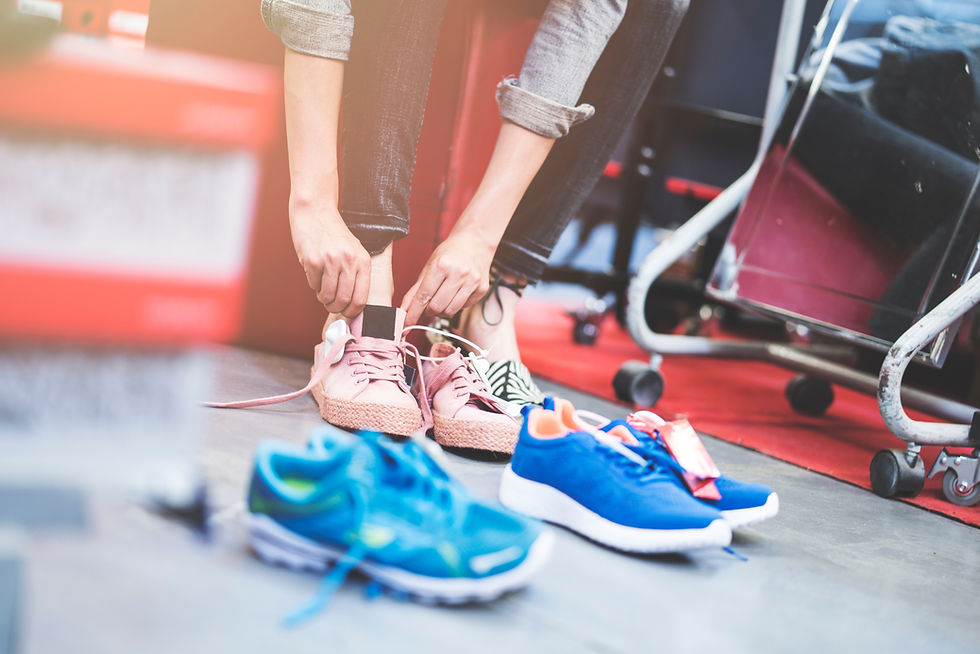How to Spot a Bunion Friendly Shoe in 10 Seconds
- yourbesttoe
- Jul 2
- 3 min read
If you’ve ever spent hours trying on shoes only to leave frustrated and empty-handed, I see you. Finding stylish and comfortable shoes is hard enough, now throw bunions into the mix, and it can feel impossible. But here’s the good news: you can train your eye to spot bunion friendly shoes in 10 seconds or less before you even slip them on.

This guide will show you exactly what to look for so you can save time, skip the trial-and-error, and zero in on styles that will work for your feet.
What Makes a Shoe Bunion Friendly?
First, let’s break down what makes a shoe not bunion friendly:
Narrow, pointed toes that squeeze your forefoot
Stiff materials that don’t flex or give
Heavy seams or stitching right where your bunion sits
Rigid soles with no cushioning or shock absorption
On the other side, bunion friendly shoes offer:
- A wider, rounder toe box to give your bunion room to breathe
- Soft, flexible materials that move with your foot
- Minimal internal seams at pressure points
- Supportive insoles that cushion and align your foot
The trick is learning to spot these features fast before you even bother with the try-on.
How to Spot Bunion Friendly Shoes in 10 Seconds
Here’s a step-by-step checklist to help you maximize your time and easily be able to spot bunion friendly shoes:
1. Look at the toe shape
Glance at the front of the shoe. If it tapers sharply or looks pointed, put it back on the shelf. Aim for rounded, almond-shaped, or square toes. These shapes naturally give your forefoot and bunion more space.
2. Check the width at the forefoot
Hold the shoe at eye level and compare the width at the ball of the foot to the width at the heel. A bunion friendly shoe will look roomy at the front, not just in length but in width.
3. Give the upper of the shoe a squeeze
Give the material a gentle squeeze. Does it flex easily, or does it feel stiff and rigid? Good material options for bunions are soft leather, knit fabrics, and stretch panels.
Is the shoe made of hard synthetics? Those shoes won’t work for your feet.
4. Peek inside for seams
Quickly check the inside of the shoe, especially where your bunion sits. Look for smooth linings and minimal stitching. If the shoe has big, bulky seams the shoes will rub and irritate your bunion over time.
5. Bend the sole
Gently flex the shoe at the ball of the foot. A bunion friendly shoe will have some give, allowing for natural movement. If the soles are rigid, they won’t accommodate your foot’s motion and may worsen bunion pain.
6. Spot hidden stretch panels
Many brands now add subtle stretch panels near the bunion area that are a big plus if you have bunions. We see these especially in ballet flats, loafers, and booties. A quick glance at the side of the shoe can reveal this bonus feature.
7. Look for adjustable features
Buckles, laces, or velcro straps can help you fine tune the fit and relieve pressure where you need it most. Shoes with these features are a big positive if you have bunions.
8. Consider the heel height
If you’re scanning heels, limit yourself to styles with block heels under 2 inches. Lower, sturdier heels put less strain on the forefoot and your bunion. Wedges are a good option if you want a higher heel.
9. Check if they come in wide widths
Even if the sample pair at the store isn’t wide, look at the tag or box, many brands offer wide or extra-wide versions of their styles. We find that many stores don’t carry wide versions of shoes, so you need to get them online. To help, start with our real-world shoe review guide at Shoe Reviews for Wide Feet & Bunions | YourBestToe.com |. You can filter by shoes we’ve tried and tested that are bunion friendly or available in wide.
10. Trust your gut
If a shoe looks like it will pinch or rub, it probably will. Save yourself the hassle and move on.
Why It Matters
Spotting bunion friendly shoes quickly isn’t just about saving time, though that’s a big win! It’s about protecting your feet from unnecessary pain and irritation. The wrong shoes can aggravate your bunion, leading to more discomfort or even making them worse over time.
With these 10-second checks, you can shop smarter, feel more confident, and actually enjoy building your shoe wardrobe again. No more wasting time trying on pair after pair only to end up disappointed. With these quick visual checks, you’ll become a pro at spotting bunion friendly shoes in seconds. Remember: the right shoes don’t just look good, they feel good, too. And your feet deserve nothing less.




Comments